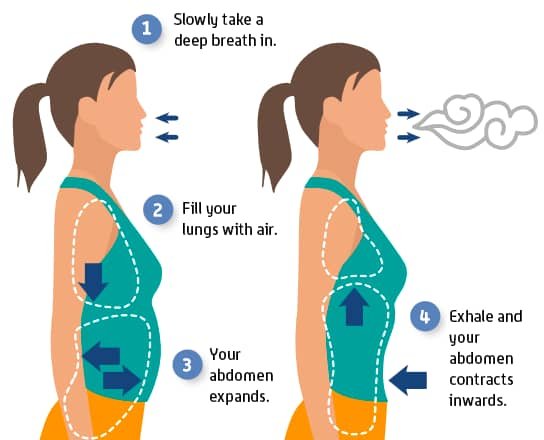Use your core muscles for beautiful shinobue tone
How your body during diaphragmatic breathing. (Courtesy: OnePointHealth)
Stand up right now and pretend that you took on a “weight loss” challenge for a million-dollar prize and needed to take extremely impressive “Before” and “After” pictures. To take the “Before” picture, you inhale using diaphragmatic breathing, expand your waistline, and HOLD it while your sister takes 20 photos from different angles. Now, observe what your body is doing. How are you keeping your waistline big? That's right. You are using your core muscles to keep looking big on your waistline. In other words, you use core muscles to keep the air inside your lungs.
This is precisely what needs to happen when you play shinobue. Once you inhale using the diaphragmatic breathing that I showed you last week , you KEEP the air inside your lungs. And as you start using the air to vibrate the shinobue, you use your core muscles to CONTROL THE AIRFLOW. If you do not use your core muscles, the air you inhaled would come all out in your first few notes of the phrase, and you will quickly deflate like a balloon without a tied knot. This results in a windy tone, and you run out of air in the middle of the phrase.
Don't blow air using your mouth like you would when blowing candles.
As I have said many times, shinobue responds best to SLOW breath. Many people blow way too much air, way too fast, blowing with their mouths. If you want a beautiful and big tone, you must use slow air propelled from the stomach and butt (core muscles). Blowing air with your mouth right at the mouth hole creates fast air, resulting in a windy tone.
Homework:
Practice diaphragmatic breathing often so it becomes natural to you.
Before you play a phrase, inhale using diaphragmatic breathing. Make sure your waistline (front sides and back) expands.
Keep your waistline expanded by using the core muscles.
Put in a “SLOW” and “HEAVY” breath by controlling the airflow with your core muscles.
Since you use the core muscles (not your mouth) to propel the air, your mouth stays relaxed. This is how Bunta sensei’s cheeks are so relaxed!
Practice this with one or a few notes over and over. Listen to your shinobue and build a relationship.
This is not something you can master overnight. It will take months/ years, maybe even decades! You get better a little by little every day. Learning how to play shinobue is a journey and lifestyle. Shinobue teaches you patience, love, discipline, dedication, meditation, focus, commitment, dream, hope, calmness, peace, beauty, creativity…!! I am so glad I took on this instrument, and I cannot help but share it with everyone!!!!!!!


